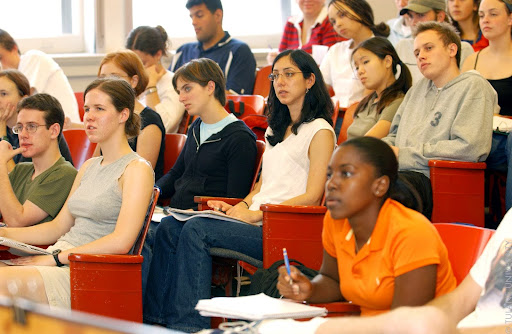According to the National Center for Education Statistics, only 12.4% of 18- 21-year-olds were enrolled in college less than a century ago. This number nearly quadrupled by 2022, up to 39% of 18- 24-year-olds. With more and more young adults pursuing a higher education over the years, the practice of attending college is more expected, and less celebrated.
Celebrations are nearly always occasions to dress up in pantsuits, tuxedos or dresses, which all fall into the category of “fancy clothes.” Some celebrations, a graduation party, for example, are nice-casual occasions with most attendees wearing jeans, khakis, a button-down shirt or a cute blouse.
Attending college classes a century ago was a celebration of sorts, symbolizing an uncommon chance at an improved life, and those taking advantage of that chance dressed for the occasion.
Now, going to a college class is just another chance to hang out with friends, maybe take a few notes, but certainly not a reason to dress up.
Does this trend toward casual clothes — sweatpants, sweatshirts and tennis shoes — reflect a larger societal trend toward less professionalism? Are these trends a negative thing? Do they impact a student’s mental capabilities?
Guilford College’s professors and students have their opinions in this matter, and their clothing may reflect those opinions.
Personally, as a female Early College student at Guilford College full time, I see these different styles, and participate in both. Sometimes I go to class with makeup, my hair fixed, nice jeans and a top that could be worn to any number of celebratory or formal occasions; yet other days are the opposite as I opt for baggy sweatpants, a random T-shirt and a messy ponytail.
What I have noticed is that when dressing nicely, I focus better, am able to stay awake during class (a struggle for most Guilford students who have schedules filled with sports practices and homework) and can think more clearly.
On the other hand, even if there is a big test that could mean success or failure in a class, if I wear too-casual clothes my concentration is elusive. Researchers for the Journal of Experimental Social Psychology, Hajo Adam and Adam D. Galinsky described this phenomenon as enclothed cognition, or the impact of clothing on someone’s psychological processes, including cognitive function.
So yes, the clothing someone wears does impact their learning; however, because someone wears very casual clothing does not guarantee lacking cognitive function. The style an individual adheres to is personal, and so are the effects of certain clothing styles on each person.
Hayden Moody, a sophomore at Guilford College, sums up how clothing choice has personalized effects on each person when talking about students who wear pajamas to class.
“It’s not going to bother you,” they said. “It’s in fact going to make you more comfortable.” Really, as long as an individual’s clothing helps them focus, then they should wear those clothes.
Though students may feel comfortable in their clothing, their choice creates an issue when it negatively impacts their focus. When a disregard for classroom performance comes in, a lack of professionalism may be present.
A calculus professor at the college, Ben Marlin, observes firsthand the different trends and the impact they do, or don’t, have. He noted that some students can “roll out of bed” and their disheveled appearance reflects their performance, but there are also those who are comfortable and participate in the classroom because they feel comfortable.
Dressing comfortably certainly has its benefits, but there is a line between comfortable clothing supporting performance and comfortable clothing subtracting from a learning environment.
One definition of professional is exhibiting a courteous, conscientious and generally businesslike manner in the workplace. While admittedly not always the case, businesslike attire, specifically suits, is psychologically linked to improved performance. Since I observe this link in my classroom experience, I am inclined to say that a lack of professionalism does detract from an ideal learning space.
Maybe, if everyone was at least encouraged, and hopefully did, adhere to a stricter dress code, then more students would optimize their performance, or at least attempt to put forth their best effort.
Society also seems to be shifting toward an environment where professionalism, especially in clothing, is not looked for as often, despite the workplace benefits. Moody and Marlin both recognized that the “intellectual elite,” as Marlin put it, often try to dress differently from their peers.
Some intellectuals may attempt to style their clothing to show a certain status or superiority, and that can be a downside. Nevertheless, psychological studies say a classroom focused on learning or a workplace centered around optimal outcomes will result from formal dress. This principle is especially true when applied uniformly.
While pajamas and sweatpants are comfortable, going to class or work is most often about results, and professional attire improves the cognitive function that leads to those results.







